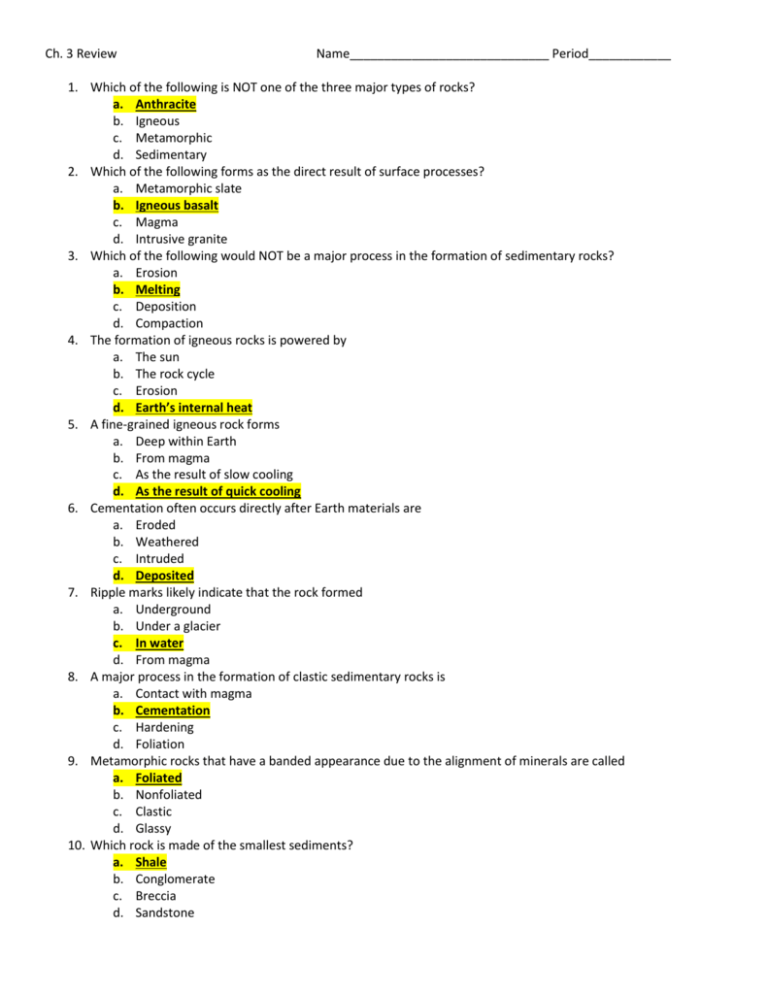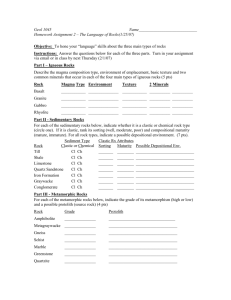Ch. 3 Review KEY
advertisement

Ch. 3 Review Name_____________________________ Period____________ 1. Which of the following is NOT one of the three major types of rocks? a. Anthracite b. Igneous c. Metamorphic d. Sedimentary 2. Which of the following forms as the direct result of surface processes? a. Metamorphic slate b. Igneous basalt c. Magma d. Intrusive granite 3. Which of the following would NOT be a major process in the formation of sedimentary rocks? a. Erosion b. Melting c. Deposition d. Compaction 4. The formation of igneous rocks is powered by a. The sun b. The rock cycle c. Erosion d. Earth’s internal heat 5. A fine-grained igneous rock forms a. Deep within Earth b. From magma c. As the result of slow cooling d. As the result of quick cooling 6. Cementation often occurs directly after Earth materials are a. Eroded b. Weathered c. Intruded d. Deposited 7. Ripple marks likely indicate that the rock formed a. Underground b. Under a glacier c. In water d. From magma 8. A major process in the formation of clastic sedimentary rocks is a. Contact with magma b. Cementation c. Hardening d. Foliation 9. Metamorphic rocks that have a banded appearance due to the alignment of minerals are called a. Foliated b. Nonfoliated c. Clastic d. Glassy 10. Which rock is made of the smallest sediments? a. Shale b. Conglomerate c. Breccia d. Sandstone 11. Use what you have learned about the rock cycle to explain the following statement: One rock is the raw material for another rock. Igneous rocks form from magma, which can be produced when any type of rock melts. Sedimentary rocks form as the result of weathering in igneous, sedimentary, or metamorphic rocks. Likewise, metamorphic rocks form when any type of rock is changed by heat, pressure, and/or hot fluids. 12. Which igneous rock forms when basaltic lava hardens? Basalt a. When basaltic magma hardens? Gabbro 13. A rock has a porphyritic texture. What can you conclude about the rock? The rock underwent at least two different (slow and quick) episodes of cooling. 14. How are granite and rhyolite the same? Both are igneous rocks with the same granitic composition. a. How are they different? Granite forms intrusively and is coarse-grained. Rhyolite formed extrusively and is fine-grained. 15. Explain the two main types of weathering. a. Chemical Changes the composition of a rock b. Physical Breaks the rock into smaller pieces 16. What are the most common minerals in clastic rocks? Clay and quartz a. Why? Clays are common products of chemical weathering and quartz is very resistant to weathering. 17. Distinguish between regional and contact metamorphism. Regional metamorphism subjects rocks to extreme changes in temp and pressure. As a result the rock undergoes structural and compositional changes. During contact metamorphism, intruding magma causes a rise in temperature of the parent rock, and changes are slight. 18. How could you easily distinguish a black and white gneiss from a similar-colored granite? The gneiss is foliated; bands of white minerals alternate with bands of black minerals. The color distribution of granite is more random. Use the diagram on page 89 to answer questions 19-22. 19. What process occurs at point A? Magma or lava solidifies/crystallizes_ 20. What three processes can occur at point B? a. weathering b. erosion c. depostion 21. Name two processes that occur at point C. a. compaction b. cementation 22. What two processes occur at points D and E? a. Metamorphism (D) b. Melting (E)







